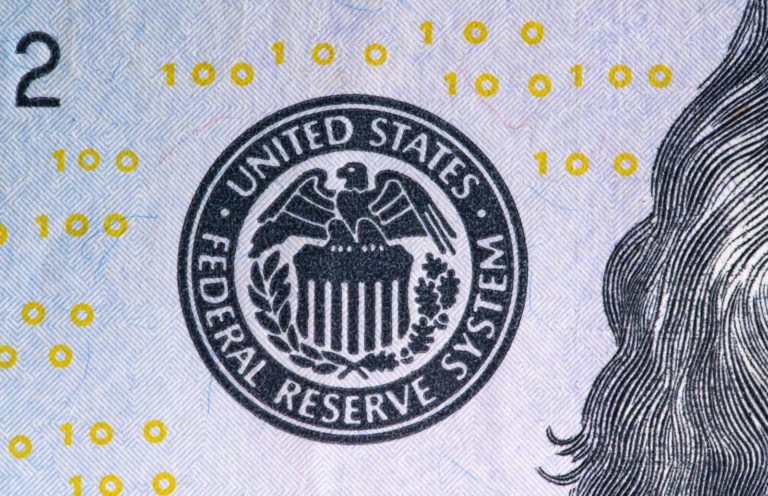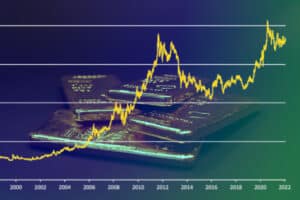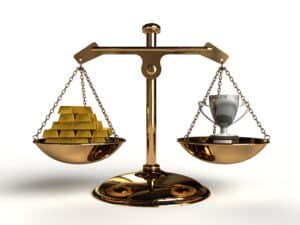Unless you’re an economist, you probably don’t spend much time thinking about the Federal Reserve. However, the Federal Reserve, commonly referred to as the Fed, is responsible for maintaining the country’s financial stability. Its actions significantly impact your day-to-day living and the country’s financial markets. This impact is especially noticeable if you rely on dollar-backed investments without diversifying your portfolio into gold or other precious metals that Noble Gold Investments offers.
Owing to several missteps in the recent past, the Federal Reserve has come under intense scrutiny from lawmakers, economists, and even Constitutional scholars. Many have started to question whether the Fed is the right system for the American economy or if the Federal Reserve is hurting America.
What Is the Federal Reserve?
The Federal Reserve is a complex institution tasked with maintaining economic and financial stability in the United States. It acts as a central bank that controls money printing, sets interest rates, and regulates other financial institutions. It also acts as a “lender of last resort,” allowing the Fed to loan businesses money during periods of economic crisis.
The Federal Reserve consists of the following three main components:
- The Federal Reserve Banks: These 12 regional reserve banks operate based on geographic location. One of the most important functions of these reserve banks is to collect information about the economic situation in their area. The banks then use this information to formulate recommendations, which they pass on to the Federal Reserve Board and Federal Open Market Committee to assist with their decision-making.
- The Federal Reserve Board: This board, sometimes known as the Board of Governors, consists of seven members nominated by the President. Its primary function is to use the Fed to fulfill the five major functions of the Federal Reserve.
- The Federal Open Market Committee (FOMC): This 12-person committee consists of the Board of Governors, the president of the Federal Reserve Bank of New York, and four of the other reserve bank presidents. The FOMC is responsible for determining key interest rates and also has the authority to sell securities.
Why Was The Fed Created?
The US economy in the 19th and early 20th centuries was an unregulated free-for-all, leading to notorious robber barons and dramatic inequality between rich and poor. This unregulated market also led to a series of financial panics that threatened to cripple the US economy for decades. Many banks did not have the liquidity necessary to meet every customer’s needs, which created bank runs. These runs frequently happened over rumors that a bank couldn’t meet the withdrawal demands of its customers, causing people to rush to their bank and withdraw their savings, often triggering a cascade of bank failures.
The solution was the 1913 Federal Reserve Act, which created a set of 12 private-public regional banks, collectively known as the Federal Reserve System. These banks were responsible for enforcing financial regulations while also being lenders of last resort and controlling the financial stability in their areas. To this day, the New York Fed regulates Wall Street and oversees one of the largest asset pools in the country.
Unfortunately, establishing federal banks was not enough to curb economic bubbles, which is why Congress passed the 1935 Banking Act. Hot on the heels of the Great Depression, this act established the Fed’s monetary policy body, the Federal Open Market Committee (FOMC). The 1977 Federal Reserve Reform Act cemented the Fed’s role as a vital economic and price stability tool.
Changes to the Reserve Over Time
The Fed has undergone several changes, often in response to market conditions and poor economic outcomes. The Fed’s two most notable policy goal changes happened in 1977 and 1978.
The Federal Reserve Reform Act of 1977 set price stability as a policy goal, while the 1978 Full Employment and Balanced Growth Act established full employment as a policy goal. Similarly, several banking regulations in the 1990s expanded the scope of the Fed to ensure banks’ solvency by enforcing several provisions.
Roles and Responsibilities of the Federal Reserve
The Fed’s three key entities—the FOMC, Board of Governors, and Federal Reserve Banks—work together to ensure the health of the US economy while maintaining the stability of the US financial system. To do so, the Fed focuses on five key areas:
- Control monetary policy to promote maximum price stability and employment.
- Promote stability by monitoring the US financial system for potential risks. The Fed’s regulatory power ensures it can implement measures to support and protect the US economy for businesses and individual Americans.
- Keep financial institutions in line. This supervisory role allows the Fed to monitor financial institutions such as banks and investment firms’ impact on the financial system and the US economy.
- Promote a safe and efficient system for US dollar transactions by creating and monitoring a payment and settlement system.
- Promote community development and consumer protection to understand how financial institutions impact customers and communities.
How Do the Federal Reserve Interest Rates Affect You?
The main tool in the Federal Reserve’s arsenal is controlling interest rates. The Fed can promote or stall economic growth by raising or lowering interest rates, which changes how people approach saving and lending.
Lowering interest rates incentivizes lending. Businesses are willing to invest more in their growth due to favorable loan terms, and consumers will spend more, which cycles money back into the economy.
Raising interest rates discourages lending. As businesses are more reluctant to take out loans, they’ll scale down their spending, as will consumers. Doing so puts a damper on the economy, which is essential in times of high inflation.
These interest rates don’t just affect business lending; they also affect ordinary citizens and can dramatically change your spending habits. Here are some of the most common ways the Fed’s policies affect your bank balance.
Credit Card Rates
Lending companies use the Federal Funds Rate to determine their prime interest rate. This interest rate forms the baseline for credit cards’ variable interest rate. Banks and credit card companies then add another interest rate margin, which varies based on a customer’s credit score and history.
Some credit card companies will state their variable interest rate as “prime + x%.” Since the prime rate changes with the Fed’s federal fund rate, any change to the federal interest rate will reflect your credit card rates.
Savings Account Rates
While rising interest rates spell terrible news for debt, they’re fantastic for individuals with savings accounts. Most banks will adjust their annual percentage yields with Fed changes. Higher interest rates also mean that people are more likely to leave their money in a savings account to reap the rewards of compound interest.
One notable aspect of the Fed’s interest rate changes is that they often respond to inflation. High inflation rates can quickly outstrip any gains you make from your savings, so you need to consider an inflation-adjusted rate of return to decide whether your savings and investment strategy make sense.
Mortgage Rates
Unlike credit card and savings rates, banks and lenders don’t use the Fed’s interest rate to determine mortgage interest rates. Instead, mortgage rates depend strongly on the ten-year Treasury yield, largely because it’s a more stable, long-term rate than the rapid-fire Fed rate.
But while the Federal Reserve doesn’t affect mortgage interest rates, it can have a more direct impact on the mortgage market. The Fed will often buy bonds or mortgage-backed securities, which impact mortgage rates—the more bonds the Fed buys, the lower the mortgage remains.
A great example is during the COVID-19 pandemic when the Fed bought almost $9 trillion in bonds. This strategy resulted in mortgage rates dropping to record lows despite the economy and inflation driving other interest rates up.
One deviation from this rule is home equity lines of credit (HELOCs). These mortgage alternatives pair their interest rates to the prime rate, and if the Fed boosts interest rates, HELOC rates will also go up.
Investment Returns
Understanding the impact of changes in the federal interest rate on investments can be challenging. On the one hand, low-interest rates lead to more investments as investors take on higher-risk lending portfolios to complement their low-yielding bonds, fixed income deposits, and certificates of deposit. At the same time, you get less return on each investment because of the lower interest amount you accrue.
High-interest rates may sound great for investors, but raising them too quickly can easily choke a market. Many investors will reshuffle their portfolios during an interest rate hike, which can remove a lot of liquidity from the financial market. Combined with fears of Fed overreach, many investors are reluctant to invest during federal interest rate increases.
Auto Loan Rates
Most auto loan lenders tie their interest rate to the prime rate, meaning that the Fed’s rate changes will also affect car loans. These changes are more of an issue for individuals with variable interest-rate auto loans since fixed-rate loans lock in their interest rates at the start of the loan term.
Criticisms of the Fed
Like just about every other government (or quasi-government) body, The Federal Reserve receives its fair share of criticism. Here are some of the main issues that citizens have raised with the Federal Reserve over the past several years.
Handling of the 2008 Recession
The Federal Reserve has a tough job, and as its regulatory role evolves, its ability to function becomes less certain. One of the most considerable changes to the Fed’s function was the partial repeal of the 1933 Glass-Steagall Act in 1999.
This repeal allowed banks more freedom in their operations and the ability to combine their retail and investment processes. Many economists view this repeal as the start of the 2008 recession. It allowed larger banks to take on riskier investments, including toxic assets such as securities based on risky home loans.
Since the Federal Reserve was supposed to monitor banks and their activities, it’s easy to criticize the Fed for its lack of preemptive action. Some economists point to the Fed’s continued long-term policy of slashing interest rates as an incentive for unsafe, unsustainable lending practices that led directly to the 2008 financial crisis.
In addition to dropping interest rates to almost 0% directly after the 2008 crisis, the Federal Reserve bank pursued quantitative easing to boost the economy. QE refers to buying assets such as Treasury bonds, mortgage-backed securities, and other forms of debt. By removing bad assets from banks’ balance sheets and increasing the amount of money the Fed could lend, investors could start investing with confidence.
Economists feared that these steps would push economic growth too far and result in out-of-control inflation. While these fears didn’t manifest, the Fed’s handling of the recession left it open to several valid criticisms. Not only did QE create new asset bubbles, but it also mainly benefited the wealthy who could afford to invest directly after the collapse.
Dodd-Frank
The 2008 recession spurred the US government to implement restrictions on banks and other financial institutions. The 2010 Dodd-Frank Wall Street Reform and Consumer Protection Act implemented numerous measures to reduce the systemic risks found in the finance sector.
Notable rules included limits on derivatives trading, the prohibition on federally backed banks making risky bets with their customers’ funds, and many other consumer-focused protections.
However, while the act implemented many banking-related regulations, it doesn’t subject other financial institutions to the same level of scrutiny.
2020 Pandemic Response
The 2020 COVID-19 pandemic had a devastating effect on the US economy. The Fed responded immediately by cutting its rates to 0%, reviving full-scale QE, and creating a range of direct-to-business lending options. From March 2020 to July 2021, the Fed doubled its balance sheet to $8 trillion and dialed back its spending by March 2022.
Rising Inflation Rates
The Fed’s actions resulted in a much faster economic recovery than after the 2008 recession but had the expected consequence of boosting inflation rates to their highest levels in decades.
As prices started to rise, Federal Reserve officials maintained that this inflation rate spike was transitory and expected after many supply chain issues and a tight labor market. Eventually, after several months of uncontrolled inflation, the Fed announced a quarter-point rate hike in March 2022 and another three-quarter point hike in June 2022.
Many economists say that the Fed hasn’t done enough to prevent inflation, which has hit 3.8% in 2022. Not only did the Fed delay too long in implementing rate increases, but its current actions aren’t enough to prevent long-term economic problems.
Equity strategies and investors believe that the Federal Reserve should have predicted this outcome and taken measures to avoid it.
Reasons To Abolish the Fed
Many Americans are dissatisfied with how the Federal Reserve has handled the country’s financial problems during the past few decades. But are these mistakes enough to justify abolishing the Federal Reserve entirely?
Many would say that the issues with the Fed go far past inaction and poor predictions. Here are some reasons Americans believe the Fed should step down as the country’s financial protector.
Devalued the US Dollar
One of the main measures of a dollar’s value is its purchasing power—what you can buy for a single dollar. Due to high inflation rates and a stagnating economy, a dollar has considerably less value than it did two years ago.
Hurts the Poor and Middle Class
The Fed’s recent inaction has led to unprecedented inflation, disproportionately affecting middle- and low-income households. However, if the Fed raises interest rates, low-income families may struggle to obtain credit or will have to rely on unscrupulous lenders instead.
Less Stable Economy
The US economy has undergone many boom/bust economic cycles that have benefited the wealthy without providing many advantages to middle- and low-income individuals. While these boom/bust cycles happen in all developed countries, some argue that the Federal Reserve has failed in its nominal commitment to stable prices and a healthy economy.
Appointed Positions
The Board of Governors and FOMC consist of individuals appointed by the President and confirmed by the Senate. In many cases, these appointments are more political than they should be, and the individuals in these positions may focus more on corporate interests than the needs of average Americans.
Unconstitutional
The US Constitution doesn’t discuss central banks or the government’s ability to create one. Since the 10th Amendment explicitly states that the federal government only has the powers granted to it, some scholars argue that the formation of the Federal Reserve violated the 10th Amendment.
Encourages Deficit Spending
Since the Fed is responsible for the country’s money supply, some argue that its ability to conjure money from nothing results in reckless spending.
Lacks Transparency
Very few people understand how the Fed operates, and this lack of clarity can lead to evil and potentially dangerous policy decisions. The problem worsens when positions are by appointment instead of a public vote, which may lead to the Board of Governors making choices that benefit them and their banking colleagues instead of the US economy as a whole.
The 2015 Fed Oversight Reform and Modernization Act alleviates this lack of transparency and accountability. The Fed must now disclose its employees’ salaries while forcing the organization to conform to the same ethical requirements as other federal financial regulators.
Alternatives to the Federal Reserve
Talking about abolishing the Fed is fine, but what other options exist? Lax regulation led to 44 recessions and six depressions before the implementation of the Federal Reserve, and only 22 recessions and one depression in the 100 years since its inception. It’s clear that markets need regulation, and several options may keep the market stable without the need for a central bank.
Gold Standard
Before paper money, physical gold was used as currency. Could it be a viable option to turn back to if the Fed is deemed too volatile in today’s economy?
Under the gold standard, a country sets a fixed price for gold and would buy and sell gold at that price, effectively setting an external value for a particular currency. America has used the gold standard, even in combination with the Federal Reserve, but switched to a fiat currency in 1971.
The main benefit of the gold standard is that it prevents a country from printing too much money. Gold takes much longer and is more challenging to create than fiat currency, making it a more stable option.
A common criticism of the Fed during the 2008 crash and 2020 pandemic was that it created money from nothing by buying bonds and pumped that money into the economy. Limiting a country’s ability to quickly and easily produce money makes the dollar stable, and inflation becomes a much smaller concern.
Department of Treasury
While the Fed controls the money supply, the US Department of Treasury is actually responsible for printing new money and could easily step into the Federal Reserve’s position.
The main drawback of this idea is that the DoT has close ties with the White House and Congress. The current Fed is relatively independent, and losing this autonomy could result in bureaucracy and economic ideologies dictating what the DoT does instead of relying on an independent Board of Governors.
Lessen the Impact of the Federal Reserve With Gold
Investing in gold offers stability and an excellent return on investment. As the dollar continues to fluctuate and inflation starts taking its toll, it’s vital to expand your investment portfolio to protect yourself and your future.
At Noble Gold Investments, we take pride in setting you up for retirement success. While it’s impossible to pinpoint the country’s state in fifty years, gold’s success throughout history only shows it’s here to stay. To find out whether a gold IRA or silver IRA is a suitable option for you and your retirement plans, our team of experts is standing by help! Call us today at (877) 646-5347 and begin saving for your future!







